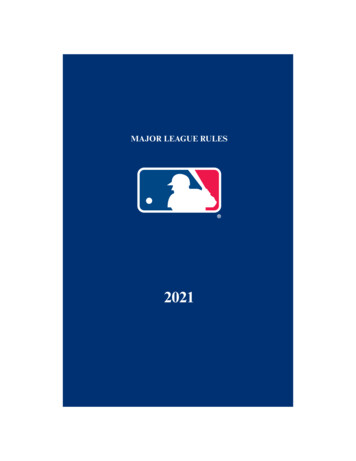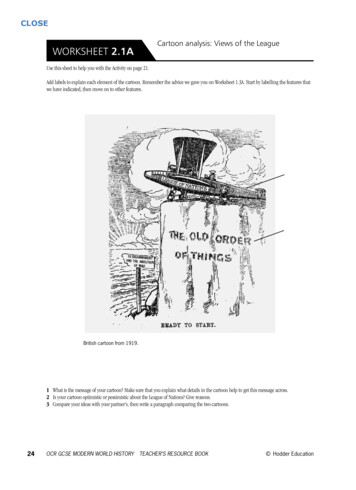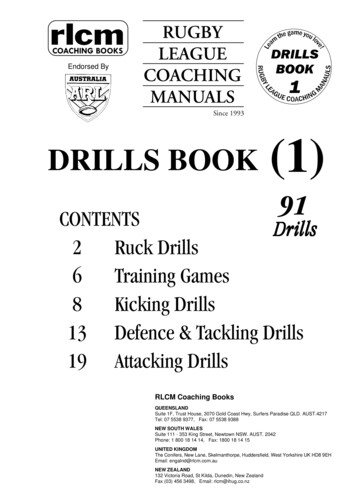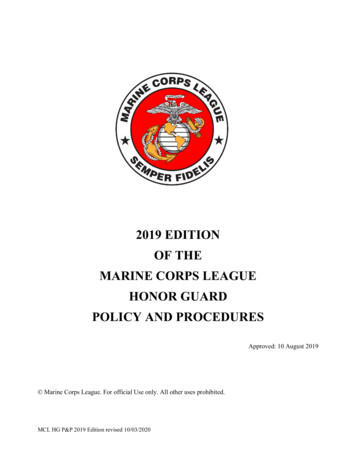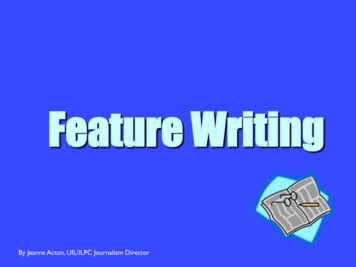
Transcription
Feature WritingBy Jeanne Acton, UIL/ILPC Journalism Director
Feature Writing tells the reader a story. It has abeginning (lead), middle and end.It uses quotes liberally and allowsthe reader to see the story throughdetailed description and vividwriting.
Transition/QuoteFormulaLinkedLead:Most interesting information.Something that will grab the reader’s attentionand drag them into the story.Nut Graph:A summary of what the storyis going to be about. Why the story isimportant.Direct Quote:Connects to the nut graph.Use more than one sentence. Direct quotesshould show the emotion of the story.Transition:Next important fact. Usetransition words to help the story flow. Theycan be facts, indirect quotes or partial quotes.LinkedDirect Quote:Connects to the firsttransition. Do not repeat the transition in thequote. DQ should elaborate on the transition.Transition:Next important fact. Usetransition words to help the story flow. Theycan be facts, indirect quotes or partial quotes.LinkedAnd so on until the story is completeDirect Quote:Connects to the secondtransition. Do not repeat the transition in thequote. DQ should elaborate on the transition.
Let's start at thebeginning with LEADS
LeadsThe opening sentence must grab andhold the reader's attention by usingspecific, interest-arousing words.
LeadsThe lead must catch the spirit of the storyand create the proper tone: serious,sarcastic, ironic, flippant, melancholy.
Leads§ Can be and often are longer than onesentence§ Your chance to grab the reader’sattention§ Should be specific to your story§ Should not be filled with cliches§ Should be in third person§ Must fit the mood or tone of the story
A Few Types of Leads§ Narrative - tells a story§ Descriptive - describes a scene, person orsubject§ Direct Quote – must be used with narrative§ Startling statement§ Contrast and Compare (then and now)§ Twist
Narrative - tells a storyJustin Greer’s 2,800 friends have never seen him cry.His father has seen him cry only once — the day lastOctober when doctors told the 16-year-old football playerthat what he thought was a bad case of the flu was actuallyleukemia.“He cried a bit then,” Mr. Greer said. “But then hesquared off and said, ʻWell, I’m not dead yet.ʼ And Ihaven‘t seen him cry since, although he’s told me thatsometimes he cries at night when he’s all alone.”
Narrative - tells a storyOn senior Alicia Brigg’s two-hour trip with herparents to church, she turned around and noticed that inthe back of the Suburban all her bags were packed.“All of the sudden, I realized I wasn‘t going tochurch; I was on my way to the airport,” she said. “Istarted screaming, crying and swearing at my dad,trying to figure out what was happening.”That’s when her dad told his 17-year-old daughterhe had put her up for adoption.
Narrative - tells a storyD.J. carried his demons clenched in his fists. The 13year-old lashed out at teachers, siblings and fosterparents. When reprimanded for his behavior, he stared athis feet and apologized in mumbles.D.J. needed hope. That much Andrea Callowayknew. Normal efforts to reach the boy didn’t work. ButCalloway knew D.J. wasn’t a normal child.When his biological parents finished beating eachother, they turned to their five kids. With D.J., theypunched him and told him he was worthless.
Descriptive - describes a scene/personDeion Sanders Jr. knows what they say in thehallways.They say he’ll be a terrible quarterback. That he’stoo short. That he can’t see squat pat the six-feetsomething offensive linemen. That he’s cocky. Thathe’ll never amount to anything.They say he’ll never be his dad.
DescriptiveIt’s too disturbing to watch the big screen TV at hiscousin’s house. Too soon. Too real.Instead, using his index fingers, Joshua Joseph twiddlesa Dove soap box, the one he used to scribble telephonenumbers on when he was evacuating.He flips the box around. There’s his girlfriend’s number.Backward.His best friend’s digits.Forward.His coach’s number.This is Joseph’s cell phone now. His real one is lost,somewhere back in New Orleans along with most of hisclothes, his family’s house and life as he knew it.
Descriptive - describes a scene or personStanding in the lunch line, the boy turned to April Halerand asked, “Will you be my girlfriend?”Then he turned to his buddy and started laughing.Just another cruel joke on the fat kid.April, who once weighed almost 300 pounds, is used tothem. Since elementary school she has been teased andtaunted about her weight.“I remember being called horrible names in elementaryschool every time we went to the playground,” thesophomore said.But life is changing.
Descriptive - describes a scene or personSarah Clark knows what they think. The smirks. The laughs.The way the other girls, all week long in cheerleading practice,have been rolling their eyes.They think she's a joke.They think she's a big fat joke of an eighth grader with noprayer of becoming a high school cheerleader.Minutes before her tryout, Sarah paces the corridor. Shesweeps the waves of her long copper hair back over hershoulder. She tugs up on her socks and down on her cheerleaderskirt, pressed the night before.Then, with her eyes open and in the privacy of her mind, shemutters a prayer.Dear God, please By 8 p.m. sheʼll have her answer.
Direct Quote - use sparingly. Must be verypowerful quote“Don‘t be mad. I took some pills,” Karen Keatoncried as she stooped over the toilet.A few hours later, the 14-year-old freshman diedafter a series of coronary arrests.
Direct Quote - use sparingly.“Coach Hawkins!”Brad Hawkins, the longtime Westlake athletictrainer, recognized Coach Steven Ramsey’s voiceover the noise of the spectators behind him. But hehad never heard Ramsey’s voice like that.Hawkins ran to Ramsey, who was crouchedover varsity player Matt Nader pleading with theathlete.“Hang in there.”“Don‘t leave us.”“Everything’s going to be all right.”
Startling Statement - createsdramaShe never knew she had it.Junior Josh Duckworth has a fetish.
Startling Statement/Narrative/DescriptiveZackary Jargowsky hates pronouns.He hates the “she” that sometimes slips outwhen he’s playing Quidditch with his friends, and the“it” he’s been labeled by the ones who don‘t understand.He hates the prolonged stares as people try tofigure out what is going on beneath his “NightmareBefore Christmas” hoodie and plaid, vertical stripedshirts — the ones the stylist said would help.
Startling Statement - createsdramaMelissa hates school.It’s not that she’s dumb. It isn’t that she doesn’tfit in socially. In fact, it isn’t that anything isparticularly wrong.It’s more of a matter of nothing being particularlyright.
Twist -sets reader up for one mood and thentwists it, surprises the readerA group of candystripers stand around the nursery, holdingincubator babies. It’s “loving time.” Another young girl steps in withher mother and picks up a baby, too. She is not in a uniform, but in ahospital gown, for the baby she holds is her own — and it’s her“loving time.”It’s also time to say good-bye.“I sat in that rocker and held him and rocked him and I criedand cried and cried,” Amber, a senior, said. “I wanted that moment tolast forever so I could always hold him and always be there for him.”“But I knew I couldn‘t. That’s what hurt.”
TwistHow many children do you have?A simple question. Unassuming. Perfect for small talk.But Jim and Julie Silcock stumble.Dec. 29, 2002 flashes in front of them. And they don‘t knowwhat to do.Haltingly, Julie responds. We have one son named James. Heis a junior at Princeton.But the questions don’t end there. For the past six years, theynever have.
Another TwistAfter tension-filled hours of last-minuteprimping, the time had come for the contestantsto walk into the arena and strut their stuff infront of the three judges and an appreciativecrowd.Some walked briskly with an air ofconfidence. Others, distracted by the lights andcameras, shuffled along slowly. A few, overcomeby the pressure, foamed at the mouth andmooed.
Even though Saturday’s market steercompetition at the Austin-Travis County LivestockShow and Rodeo was like many other beautypageants, there were some obvious differences.The contestants — steers weighing more thanhalf a ton — were being judged on the type of Tbones and rump roasts they would turn intoinstead of their appearance in an evening gown orbathing suit.
Another good one Louis Staggers smiles all the time. Not often. All.The. Time.“Louis is that kid who walks the hallway with thebiggest smile on his face,” says John Osborn, headbasketball coach at Belton High School.
Writing devices for leads§ Repetition (Melissa)§ Short, punchy sentences. Fragments. (Joshua, Louis)§ Using dialogue (adoption, Matt)§ Mixing sentence length to set a rhythm (adopt, rodeo)§ Breaking the rules starting with “And”
The lead should openwith the specific,then go to the general.
Rather than:With America engaged in a war in Iraq, manystudents know U.S. military men who have losttheir lives.Leaguetown lost one of its own last monthwhen Nicolas Barrera was killed in Iraq.
Try this:When Briana Barrera didn’t hear from her son,Nicolas, for a week she knew something waswrong. Maybe it was mother's intuition, but sheknew.And when she saw two officers walking towardher door, her worst fear was confirmed.“The officers said they were sorry to deliver thenews, but Nicolas died with honor,” she said.“Dying with honor? How does that help? My heartwas breaking. My boy was gone.”
Here’s the basic info Proyecto Adelante is a nonprofit agency thatcounsels people seeking U.S. citizenship. You interviewed Dolly Warden, a volunteerpsychologist who counsels these torturevictims. She describes the stories of severalof the victims. She is going to speak at your school nextweek. Your story comes out first.
Which is the best lead? Everyone hears stories of rape and murderfrom other countries. If you ever wanted tohelp one of these victims, you need to knowabout Proyecto Adelante. It is a non-profitagency that counsels people seeking U.S.citizenship.
Which is the best lead? You have slaved all day in a field duringwhich the temperature reached over 100degrees. You earned your dollar pay, butwhen you ask your “owner” for it, you arebrutally beaten, which causes you to misstwo days of work. That happens inGuatemala. Proyecto Adelante is trying tohelp Guatemalans escape the torture.
Which is the best lead?He can hear her screams, her pleas for mercy. He seesthe soldiers beating her, burning circles on her arms and legswith their cigarettes. He hears her gasping for air, choking onher own tears as the soldiers circle her. He breaks down as hecries out, “They left her for dead on the streets.”Psychologist Dolly Warden sits next to the youngGuatemalan, listening, consoling, growing angrier, morebitter by the second. This is no cliché. She feels his pain.When he leaves, she slams her clipboard against a filingcabinet. She screams. Even curses.“My God. What kind of animals are these?”It’s a question she’s asked dozens of times sincebecoming a volunteer at Proyecto Adelante four years ago.
Lead writing pitfalls: News or editorials leads. Avoidfirst and second person. Stating the obvious. Using cliches. “Imagine this ” leads
No news or editorials leads. Avoid firstand second personFreshman Sarah Clark made the cheerleadersquad for the 2007-08 school year.Congratulations to Sarah Clark for making thecheerleading squad. We are proud of her.
Don't state the obviousEvery day, millions of people wake up, go towork or go to school. But some days, they don't.Millions of teenagers have jobs. They workfor many reasons: college, cars, just to havesome spending money in their pocket.
No clichesTake one for the team.Life is short.And the winner is . . .
Do not “Imagine this ”Imagine what it would be like to be shot inhead with a 57-magnum.Dallas-resident Carly Patty doesn’t have to.Her little brother shot her in the faceaccidentally last summer.Imagine what it would be like to be a femalehead football coach in Texas.Nina Colt doesn’t have to. She was justnamed head football coach.
Try this instead Varsity football Coach Seamus Shift loves tojoke with his players, so earlier this month when hetold the varsity football team a woman would bereplacing him as head coach, the players laughed.“But when he didn’t laugh, we knew it wastrue,” varsity quarterback junior Emmanuel Dysonsaid.And it is true.
What's next?
After a strong lead You need a strong nutgraph.
What is a nut graph?Basically, it is a summary of whatthe story is going to be about. It’sthe 5 Ws and H that you didn’tanswer in the lead.It’s the thesis sentence of yourstory.
The NutGraphVarsity football Coach Seamus Shift loves tojoke with his players, so earlier this month when he toldthe varsity football team a woman would be replacinghim as head coach, the players laughed.“But when he didn’t laugh, we knew it wastrue,” varsity quarterback junior Emmanuel Dyson said.And it is true.Former women’s professional football playerand current varsity football coach at St. Mary’sPreparatory Academy in Florida, Nina Colt will replaceShift as varsity football coach for the 2011-2012 schoolyear. She will shadow Shift next week to meet theplayers and assistant coaches.“I want my players to be more than jocks,” shesaid. “I want them to be outstanding young men insociety. Of course, I want to win games, but winningwill never come before individual success in theclassroom and in the community.”
What's next?
After a strong lead and aninformative nut graph Use the Transition/Quoteformula
transitiondirect quotetransitiondirect quotetransitiondirect quoteShift, Principal Ed Day, a teacher and two parents were on thecommittee that hired Colt. Shift said she was everyone’s numberone candidate.“When I leave in May, this program will be in greathands,” Shift said. “Coach Colt will bring new energy to ourfootball program. I have no doubt that she was the right person tohire.”When she applied, Colt said she didn’t think she had muchof a chance.“After the panel interview, I felt pretty confident, but Ididn’t want to be cocky,” she said. “Hiring a female varsity footballcoach in Texas is a big step for a school district.”Day said he didn’t hesitate about hiring a woman as thevarsity football coach. Colt’s hire marks the third female varsityfootball coach at a Texas public school.“She was the best candidate by far, and I know she willtake our team forward,” Day said. “All of the other candidates wereselling themselves. Coach Colt was the only one who talked aboutstudents and what she’d do for them.”
ED DAY, principal“I didn’t think twice about hiring a woman as thevarsity football coach. We are not living in the 1950s.She was the best candidate by far, and I know shewill take our team forward. All of the othercandidates were selling themselves. Coach Colt wasthe only one who talked about students and whatshe’d do for them. I expect we will hear a negativecomment or two in the beginning, but I don’t expectcomments to affect Coach Colt.”Where didthosetransitionscome from?Day said he didn’t hesitate about hiring awoman as the varsity football coach. Colt’s hiremarks the third female varsity football coach at aTexas public school.“She was the best candidate by far, and Iknow she will take our team forward,” Day said.“All of the other candidates were sellingthemselves. Coach Colt was the only one whotalked about students and what she’d do for them.”
NINA COLT, 2011-2012 head varsity football coach“Frankly, I didn’t think I had much of a shot at acoaching position at a Texas public school, but I’venever shied away from a challenge. After the panelinterview, I felt pretty confident, but I didn’t want tobe cocky. Hiring a female varsity football coach inTexas is a big step for a school district. I look forwardto the challenge and the opportunity. I have thehighest respect for Coach Shift and his program.Where didthosetransitionscome from?When she applied, Colt said shedidn’t think she had much of a chance.“After the panel interview, I feltpretty confident, but I didn’t want to becocky,” she said. “Hiring a female varsityfootball coach in Texas is a big step for aschool district.”
So how do you enda feature story?
End your story with - A powerful quoteOr- Tie the ending back to the lead
For example:(Lead) “Don‘t be mad. I took some pills,” KarenKeaton cried as she stooped over the toilet.A few hours later, the 14-year-old freshmandied after a series of coronary arrests.(Ending) Since the death of her oldest daughter, theKeatons have found themselves becoming moreprotective. “I find myself watching for things,” Mrs.Keaton said. “I’m not sure for what. I’m justwatching.”
For example:(Lead) A group of candystripers stand around thenursery, holding incubator babies. It’s “loving time.”Another young girls steps in with her mother and picksup a baby, too. She is not in a uniform, but a in ahospital gown, for the baby she holds is her own — andit’s her “loving time.”It’s also time to say good-bye.“I sat in that rocker and held him and rockedhim and I cried and cried and cried,” Amber, a senior,said. “I wanted that moment to last forever so I couldalways hold him and always be there for him.”“But I knew I couldn’t. That’s what hurt.”
(Ending) This was evident as she stated the one word thatdescribed the whole ordeal:“Pain,” she said, tears streaming down her cheeksand falling onto her sweater.“True pain.”
For a Strong Feature Storyremember this GQ STUDD
GQGreatSTUDDStrong LeadQuotesTransition/Quote FormulaUnique AngleDescription - Show Don't TellDetail
Yes, you can § Use the first name on the secondreference if the story is about astudent.§ Add plausible description to fleshout your lead§ Have a lead longer than oneparagraph
Pitfalls to avoid in feature writing § Using a news lead§ Writing in the passive voice§ Using too many adverbs and adjectivesinstead of specific nouns and powerfulverbs§ Messy handwriting§ Story doesn’t flow – doesn’t use T/Qformula§ Lack of strong quotes
On contest day ! Read the entire prompt! Take a moment. Remember whatstands out to you. Try to use that for yourlead.! Reread the prompt and highlight orunderline powerful quotes.! Also, mark your nut graph (usuallythe news peg) in the prompt.! Cross out any unnecessary quotes orpeople.! Write.
Lead: Most interesting information. Something that will grab the reader’s attention and drag them into the story. Nut Graph: A summary of what the story is going to be about. Why the story is important. Direct Quote: Connects to the nut graph. Use more than one sentence. Direct quotes should show the em
